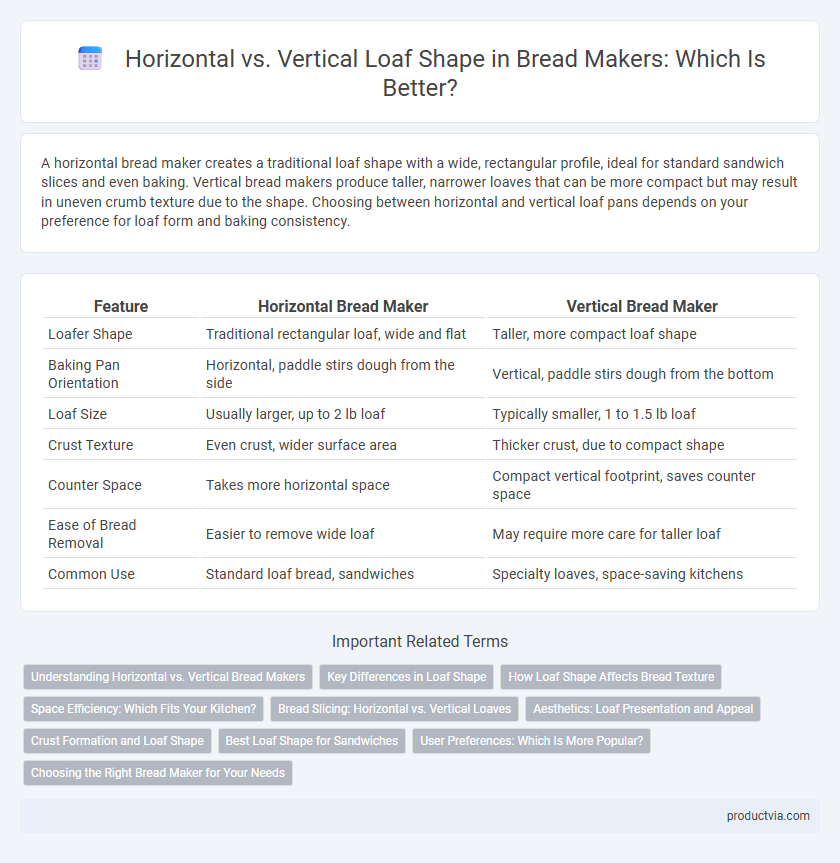A horizontal bread maker creates a traditional loaf shape with a wide, rectangular profile, ideal for standard sandwich slices and even baking. Vertical bread makers produce taller, narrower loaves that can be more compact but may result in uneven crumb texture due to the shape. Choosing between horizontal and vertical loaf pans depends on your preference for loaf form and baking consistency.
Table of Comparison
| Feature | Horizontal Bread Maker | Vertical Bread Maker |
|---|---|---|
| Loafer Shape | Traditional rectangular loaf, wide and flat | Taller, more compact loaf shape |
| Baking Pan Orientation | Horizontal, paddle stirs dough from the side | Vertical, paddle stirs dough from the bottom |
| Loaf Size | Usually larger, up to 2 lb loaf | Typically smaller, 1 to 1.5 lb loaf |
| Crust Texture | Even crust, wider surface area | Thicker crust, due to compact shape |
| Counter Space | Takes more horizontal space | Compact vertical footprint, saves counter space |
| Ease of Bread Removal | Easier to remove wide loaf | May require more care for taller loaf |
| Common Use | Standard loaf bread, sandwiches | Specialty loaves, space-saving kitchens |
Understanding Horizontal vs. Vertical Bread Makers
Horizontal bread makers produce traditional loaf shapes with a wider, more rectangular form, ideal for classic sandwich breads and consistent crumb structure. Vertical bread makers create taller, narrower loaves that are space-efficient and often bake faster due to their shape, suitable for smaller kitchens. Choosing between horizontal and vertical models influences the bread's texture, baking time, and loaf dimensions based on user preferences and kitchen space.
Key Differences in Loaf Shape
Horizontal bread makers typically produce loaves with a traditional rectangular shape featuring a wider base and lower height, optimizing crust-to-crumb ratio for even baking. Vertical bread makers create taller, slimmer loaves with a more pronounced dome shape, offering a fluffier interior but a thinner crust. The choice between horizontal and vertical loaf pans directly impacts the bread's texture, crust thickness, and slicing convenience.
How Loaf Shape Affects Bread Texture
Horizontal bread makers typically produce wider, flatter loaves with a tender crumb due to more even heat distribution and a larger baking surface, enhancing crust development. Vertical bread makers create taller, narrower loaves that often result in a denser texture and thicker crust, as the dough rises upwards and heat concentrates around a smaller area. The loaf shape directly influences the crumb structure and crust quality, impacting the overall mouthfeel and freshness of homemade bread.
Space Efficiency: Which Fits Your Kitchen?
Horizontal bread makers typically offer a traditional loafer shape, providing more internal space for evenly baked, larger loaves, but they require considerable countertop space. Vertical bread makers have a compact footprint with a taller, narrower loaf shape, making them ideal for kitchens with limited counter space. Choosing between horizontal vs vertical models depends on balancing the desired loaf size with the available kitchen space efficiency.
Bread Slicing: Horizontal vs. Vertical Loaves
Horizontal bread makers produce wider, flatter loaves ideal for traditional sandwich slicing and even toasting, enhancing uniform crumb texture. Vertical bread makers create taller, more cylindrical loaves suited for thick slicing and artisanal presentation, with a denser crust and open crumb structure. Choice between horizontal and vertical loaf shape impacts slicing style, texture consistency, and bread aesthetics for different consumer preferences.
Aesthetics: Loaf Presentation and Appeal
Horizontal bread makers create loaf shapes with a wider, flatter profile that enhances crust browning and provides a traditional bakery appearance ideal for sandwiches. Vertical bread makers produce taller, more cylindrical loaves that offer a unique presentation but may have less even browning on the sides. The choice between horizontal and vertical machines significantly impacts the visual appeal and texture distribution of the finished loaf.
Crust Formation and Loaf Shape
Horizontal bread makers create wider, rectangular loaves offering even crust formation on all sides, which is ideal for consistent baking and slicing. Vertical bread makers produce taller, more cylindrical loaves with a thicker crust on the sides and bottom, often resulting in a denser crumb structure. The choice between horizontal and vertical shapes directly impacts the loaf's texture and crust-to-crumb ratio, influencing both appearance and taste.
Best Loaf Shape for Sandwiches
Horizontal bread makers produce loaf shapes that are wider and flatter, ideal for evenly sized sandwich slices that fit standard sandwich bread requirements. Vertical bread makers typically yield taller, more cylindrical loaves, which may create uneven slices that are less optimal for uniform sandwiches. For the best sandwich loaf shape, horizontal bread makers are preferred due to their consistent, rectangular slices perfect for stacking and layering.
User Preferences: Which Is More Popular?
Horizontal bread makers are generally more popular among users who prefer a traditional loaf shape resembling bakery-style bread, as the wider pan allows for a broader, flatter loaf. Vertical bread makers appeal to those with limited countertop space or who favor a taller, more compact loaf shape, though they are less common in user preference rankings. Reviews indicate that while horizontal models dominate the market due to their loaf aesthetics and even baking, vertical models attract a niche segment valuing convenience and space efficiency.
Choosing the Right Bread Maker for Your Needs
Horizontal bread makers produce traditional loaf shapes ideal for standard sandwich slices, maximizing space efficiency and even baking. Vertical bread makers create taller, more cylindrical loaves suitable for artisan-style breads but may require more counter space. Choosing between horizontal and vertical models depends on loaf shape preferences, kitchen layout, and desired bread texture.
Horizontal vs Vertical for loafer shape Infographic

 productvia.com
productvia.com